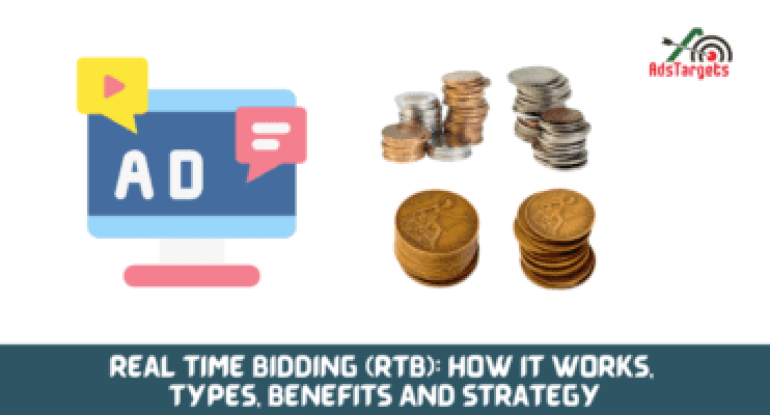Manuscript: Ten dollars going once…going twice… and sold to the highest bidder! yeaaaah
Real time bidding is an auction setting where ad impressions are sold and bought, and these transactions take place in a blink of an eye.
Once an advertiser’s bid wins the auction, their digital ad is immediately shown on the website or platform of the publisher.
RTB auctions place the focus on impression-based bidding whereas static auctions tend to group impressions only allowing advertisers to bid on them in package deals.
RTB enables both publishers’ websites and advertisers to control the bidding process by setting parameters such as the highest bid.
The process can be a turning point for publishers looking to smoothen the sale of their inventory.
You might have guessed it, and you are right if you guessed that in this article we are going to be discussing real-time bidding in advertising.
Table of Contents
ToggleHow does Real Time Bidding work

When a user visits a site, a corresponding bid request is sent to an Ad Exchange.
This bid request then contains several types of information such as demographical data, location information, browser history, etc.
The Ad exchange then sends the bid requests along to its list of advertisers/buyers who bid in real-time for the ad impression as it gets presented to the site user.
The advertiser that bids the highest amount wins the impression and gets its ad served in front of the website user.
This same process gets repeated every time for every ad unit of the website property page.
This course of action takes place within 100 milliseconds, including receiving the bid request and serving the ad.
What Are The Different RTB Options Out There?
There are various variations to real-time bidding (RTB) that include header bidding, first-price auction, and second-price auction.
Let’s take a closer look at these options:
#1. Header Bidding
Header bidding is an advanced programmatic advertising approach that serves as an option to the Google “waterfall” approach.
It is also sometimes referred to as advance bidding or pre-bidding and provides publishers a way to concurrently offer ad space out to various SSPs or Ad Exchanges at once.
Usually, when a publisher is trying to sell advertising space on its website, the process for filling inventory goes like this:
First, your site connects to your ad server. In general, direct-sold inventory supersedes any programmatically sold options.
Next, available inventory is served via the site’s ad server, such as Google DoubleClick in a waterfall order, meaning unsold inventory is offered first to the top-ranked ad exchange, and then whatever is left unsold is passed along to the second ad exchange, and so on.
These rankings are normally determined by size, but the biggest ones aren’t automatically the ones willing to pay the highest price.
(For publishers, this indicates lower overall returns if the inventory isn’t automatically going to the highest bidder.)
To further make the process complex, sites using Google’s DFP for Publishers have a setting that allows them to outbid the highest bidder by a penny using Google Ad Exchange (AdX).
And since AdX gets the last bid, they are principally in a position to win most of these auctions.
Publishers end up feeling like they are not making quite as much money as they would without Google interfering in the bids.
#2. First-Price Auctions
A type of auction framework in programmatic advertising, first-price auctions are where buyers bid for ad impressions and the highest bid wins and then the winner pays the amount they bid, and the ad is served.
In some instances, a floor price may be set by the seller which is the modest price they will accept. First-price auctions can be private or public.
Bid shading has emerged to help stop media buyers from overpaying for impressions in these auction types.
#3. Second-Price Auctions
second-price auctions are where the highest bid wins but only pays the price equal to the second-highest bid plus one cent.
So if Buyer A bids 3.50 Euros and Buyer Z bids 4 Euros, Buyer B would win but would only pay 2.51 Euros.
Second-price auctions seem to be most popular among advertisers, as the winning bid only pays $0.01 more than their closest competitor to seal the deal.
It benefits advertisers as they can bid the maximum they would be ready to pay while still ensuring they don’t pay above the actual market value.
Advantages of Real-Time Bidding for Publishers
The six Key Benefits of Real-Time Bidding (RTB) for publishers
#1. They can control which content and format will be shown on their websites or mobile apps. They can even ban ads with sensitive or inappropriate content.
#2. They can sell their unsold inventory at a higher cost.
#3. Publishers can modify prices according to demand and bids.
#4. They know who the advertisers are, and can custom their offerings accordingly.
#6 Private marketplaces enable publishers to sell premium inventory to specific companies. Publishers can ensure the ads displayed are relevant to their audience.
Some Drawbacks of Real-time bidding (RTB)
#1. Compromising User Data for Targeting Reason
Since RTB depends on users’ data gathered through cookies, it is sometimes demanding for a publisher to observe all data regulations.
For example, if a publisher’s website is displayed to an EU audience, then it must comply with the General Data Protection Regulation (GDPR).
This is one of the major downsides of Real-Time Bidding as the publisher need to share the user data with advertisers to serve the relevant ads at all time.
#2. No Guaranteed Deal
Unlike programmatic guaranteed deals, real-time bidding entirely depends on the demand and supply rule to fill the available inventory.
The publisher will augment the revenue on a few ad units and lesser revenue on a few ad units because of the demand or number of buyers taking part in the auction to serve the ad at that moment.
Also, there is no guarantee that the ad will be filled through RTB all the time as it is reliant on the buyers’ interest to serve the ad.
This has a direct influence on the publisher`s revenue and the publisher needs to keep tracking their ad unit revenue and optimize correspondingly.
Benefits of Real-Time Bidding for Advertisers

#1. The key benefit of real-time bidding (RTB) for advertisers lies in the greater control they have over their campaigns.
#2. They can control where their ads will show. They can choose where they want to present their products.
#3. They can narrow the target audience by demographics, location, languages, or other options.
#4. They can adjust marketing strategies as they go, depending on RTB campaign results.
#5. They can utilize tools such as bid forecasting to improve their marketing campaigns.
#6. Advertisers can keep ad campaigns within budget by leveraging the maximum bids alternative and avoiding buying impressions in bulk
Drawbacks for Advertisers
#1. Since software makes the eventual decision based on data, the lack of human involvement and the automated process highlights the importance of quality software and finding the best real-time bidding platforms.
#2. There are some instances when your ad can end up on the wrong site, where its content is completely at odds with what’s on the web page.
Are Programmatic Advertising and RTB the Same Thing?
Programmatic advertising and Real-time bidding (RTB) are not carbon-copy terms, with the latter being a single category under the umbrella of programmatic advertising.
Programmatic advertising is an automated process that enables publishers and advertisers to automate their deals for ad units.
Besides, RTB is just one of four deal types, which also incorporate private marketplace (PMP), preferred, and programmatic guaranteed deals.
Let’s take a look at them in better detail
#1. RTB
Real-time bidding is the most widespread form of programmatic media buying and enables a single ad impression to be sold.
Anyone can bid on available ad units through an open auction, with the highest bids winning the inventory.
#2. Private Marketplace (PMP)
PMP deals are fundamentally invite-only RTB auctions, in which the publisher controls which advertisers will make the guestlist.
The attraction for publishers is that they can sell off premium ad space to buyers with bottomless purses.
Meanwhile, advertisers know exactly where their ads are being served, giving them more information about the return on ad spend (ROAS).
#3. Preferred
Publishers leverage this format to provide their preferred advertisers with the right of first refusal to buy ad inventory, without any duty to buy.
Much like the PMP procedure, preferred deals enable publishers to sell off premium ad space to those advertisers with deep pockets.
#4. Programmatic Guaranteed
This approach imitates the traditional style of ad sales, in which the advertiser and publisher will negotiate directly over the sale of inventory and doesn’t require bidding.
Again, this method allows publishers to extract a premium for their most desirable ad units, while advertisers can ensure more sifted performance data.
5 proofs that RTB works for Marketers and Their Agencies
#1. Precision targeting
RTB allows marketers to choose and compile the audience that they want to reach and bid, to display a different ad to a specific audience, based on data about that audience.
This is because information about the user’s browsing habits is communicated in real-time from their browser to an ad exchange and is important for the outcome of the auction.
The presence of third-party data providers also enables more precise behavioral targeting.
This allows you to deliver the right ad to the right person at the right time using verified data.
#2. Content and contextual transparency
It’s your data and you have the right to know every site that every impression ran on, what hours of the day, what browsers, days of the week, devices, operating systems, and so on. Real-time bidding looks at about 80 different data points.
#3. Reduce advertising waste and optimize faster
Reaching more relevant users cuts down on advertising costs and waste, something the industry is known for.
Due to the high-quality matching of the right audience with the right ad, RTB allows for better budget management and a higher return on investment (ROI).
Bidding on an impression-by-impression basis and utilizing ad tech opens up a huge range of inventory across a wide range of sites. Advertisers can then be selective in choosing the impressions that are most accessible to them.
Real-Time Bidding offers more recent and detailed data compared to data obtained from ad networks.
Therefore, it enables you to make informed decisions and optimize more quickly towards your KPIs using real-time data.
#4. Viewability
Display viewability of digital advertising assists you in understanding the chances of an impression being seen by a user and the potential value of publisher inventory to make smarter bidding choices.
#5. Reach
Having access to numerous sources of inventory such as open ad exchanges, hundreds of thousands of websites, and billions of impressions, via Demand Side Platforms (DSPs) and the ability to use different formats and sizes of ad units, license the advertisers and allows them to reach different audiences and devices.
Conclusion
Real-Time Bidding creates a flourishing environment for both advertisers and publishers to have maximum control over the ad-serving activities, optimizing the floor prices on an up-to-the-minute basis, managing their inventory successfully, and improving the user experience by serving the relevant ads.
RTB is especially beneficial for prospecting and retargeting.
Whether you are already using RTB, or are thinking about using it, realizing some of its benefits can prove useful to any marketing organization.
However, it comes up with some challenges like compromising the user data for better targeting, there isn’t any guarantee of serving the ads at all times, and brand safety from both parties.








